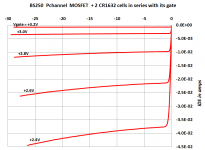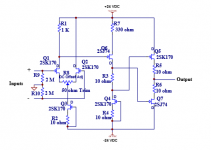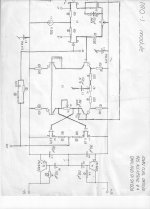Sadly neither. The joy of marrying a vegetarian. The benefits are worth it though 🙂
I should have remembered, have to do stuffed portabellos for one of our guests today.
That is not going to happen in the next decade or two. Digital has a LONG, LONG way to go to beat the the best analog. It's the same with SMPS power supplies, they will have to make some big leaps in switching noise control to beat a linear power supply in clean sound.
You're certainly entitled to your opinion, but the industry goes as usual it's own way. I expect the digital engines are not the problem and personal taste in analog "effects" are the issue. There will never be a major "Wavac style" DAC or A/D. If John thought the Wavac was the best analog it certainly wasn't for signal fidelity.
What for?
Part of the ' magic ' of tubes is that they are depletion mode .
A positive going signal ' releases ' rather than ' drags ' the
electron flow ..... Hence ease of presentation .
Part of the ' utility ' of transistors is the availability of
complementary devices .
Complementary depletion mode power mosfets would allow a
' best of both worlds ' output stage .
Which you can synthesize for $3.00 using a battery, a capacitor, and an enhancement mode PMOS. Just remember to replace the battery every N hours and Bob's your uncle. You could program the microcontroller (the one that runs the vacuum fluorescent display on the front panel of your amplifier) to nag the owner after (N-2) hours and then refuse to play after (N+8) hours.What the world needs is a P-channel depletion-mode power-mosfet
Part of the ' magic ' of tubes is that they are depletion mode .
A positive going signal ' releases ' rather than ' drags ' the
electron flow ..... Hence ease of presentation .

Which you can synthesize for $3.00 using a battery, a capacitor, and an enhancement mode PMOS. Just remember to replace the battery every N hours and Bob's your uncle. You could program the microcontroller (the one that runs the vacuum fluorescent display on the front panel of your amplifier) to nag the owner after (N-2) hours and then refuse to play after (N+8) hours.
Don't rule out Scott's method of an LED driven photovoltaic source.
Don't rule out Scott's method of an LED driven photovoltaic source.
I was just about to say that. It's actually the application that they were intended for, most are found under photovoltaic mosfet driver.
Ah the good old days! Merry Christmas
Not a USB or HDMI port to be seen!
Not a USB or HDMI port to be seen!
Attachments
Last edited:
Not a USB or HDMI port to be seen!
That's what I remember.
Not a USB or HDMI port to be seen!
No GFCI's either, hot chassis in the kitchen (to the tune of Pat Benatar).
I made a mockup using an enhanement mode Pchannel MOSFET. To stay within the modest current limitations of my curve tracer I used a small signal MOSFET, but since gate current is negligible, the same approach will work on a high power MOSFET with no additional modifications.What the world needs is a P-channel depletion-mode power-mosfet
This assemblage created a depletion mode PMOS whose pinchoff voltage is about +3.4V; we see it is just barely conducting at +3.2V. Remember that enhancement mode PMOS devices have a gate turnon threshold voltage which is a negative number; BS250's datasheet says (-3.5v < Vth < -1.0v).
With a photovoltaic isolator and potentiometer you could literally dial up whatever pinchoff voltage you wanted.
_
Attachments
A full array of complementary enhancement and depletion mode mosfets would be ideal. Apparently, like audio optimized IC op amps, there just is not enough market for depletion mode mosfets to make it worthwhile. I was asked what I wanted (about 40 years ago) by a Siliconix engineer and I said just that, BUT to no avail.
Actually, depletion mode is more difficult to bias (normally) except for making current sources, and this was brought out by the introduction of Vfets in the 1970's. I made an amp out of them, but biasing was difficult for the output stage. Vfets had another problem, low output resistance or Mu, so even complementary output stages were VERY sensitive to power supply voltage regulation.
Actually, depletion mode is more difficult to bias (normally) except for making current sources, and this was brought out by the introduction of Vfets in the 1970's. I made an amp out of them, but biasing was difficult for the output stage. Vfets had another problem, low output resistance or Mu, so even complementary output stages were VERY sensitive to power supply voltage regulation.
With a photovoltaic isolator and potentiometer you could literally dial up whatever threshold voltage you wanted: enhancement mode, depletion mode, or zero threshold. (We used those to great advantage in HMOS-I on 3 inch wafers). You could even shell out for 25 turn trimmers and get matched VT's for minimum offset.A full array of complementary enhancement and depletion mode mosfets would be ideal.
I should have said "what the world needs is a complementary pair of
lateral depletion-mode mosfets"
lateral depletion-mode mosfets"
That is not going to happen in the next decade or two. Digital has a LONG, LONG way to go to beat the the best analog. It's the same with SMPS power supplies, they will have to make some big leaps in switching noise control to beat a linear power supply in clean sound.
Hmmm, you may have missed some developments in electronics in the past 30 years or so...
I also wonder why recording these days is all done in digital, maybe you should inform them that they are doing it wrong...
- Status
- Not open for further replies.
- Home
- Member Areas
- The Lounge
- John Curl's Blowtorch preamplifier part II



